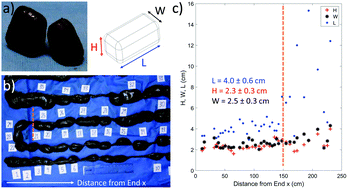Intestines of non-uniform stiffness mold the corners of wombat feces†
Abstract
The bare-nosed wombat (Vombatus ursinus) is a fossorial, herbivorous, Australian marsupial, renowned for its cubic feces. However, the ability of the wombat's soft intestine to sculpt flat faces and sharp corners in feces is poorly understood. In this combined experimental and numerical study, we show one mechanism for the formation of corners in a highly damped environment. Wombat dissections show that cubes are formed within the last 17 percent of the intestine. Using histology and tensile testing, we discover that the cross-section of the intestine exhibits regions with a two-fold increase in thickness and a four-fold increase in stiffness, which we hypothesize facilitates the formation of corners by contractions of the intestine. Using a mathematical model, we simulate a series of azimuthal contractions of a damped elastic ring composed of alternating stiff and soft regions. Increased stiffness ratio and higher Reynolds number yield shapes that are more square. The corners arise from faster contraction in the stiff regions and relatively slower movement in the center of the soft regions. These results may have applications in manufacturing, clinical pathology, and digestive health.

- This article is part of the themed collections: Soft Matter Editor-in-Chief's Choice and Soft Matter Most Popular 2021


 Please wait while we load your content...
Please wait while we load your content...